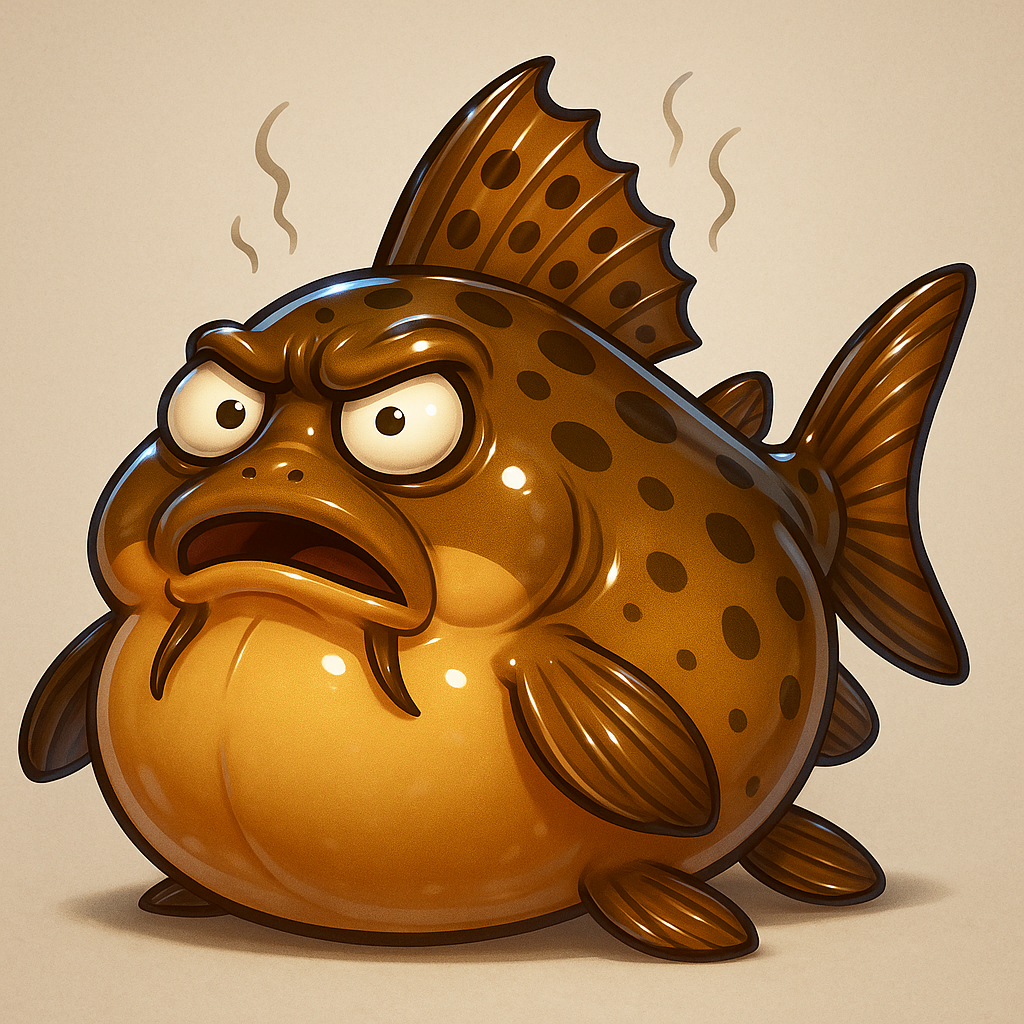Pleco Bloat: Complete Triage & Treatment
💥 Pleco Bloat: Complete Triage & Treatment
🚑 First 60 minutes (do this now)
- 💧 Water change: 50% (match temp), dechlorinate (chloramine-safe).
- 🌬️ Max oxygen: Add airstone + point a filter return at the surface.
- 🍽️ Stop feeding 24–48 h.
- 🧪 Test: NH₃ = 0, NO₂⁻ = 0, NO₃⁻ < 40 ppm (≤20 ppm for sensitive species).
- 🏥 Hospital tank if: severe swelling, lethargy, pineconing (raised scales), or gasping.
🕵️ Rapid differential (what kind of bloat?)
| Signs | Most likely | Notes |
|---|---|---|
| Swollen but alert, normal color; recent heavy meal; dark/solid poop | Constipation/gas | Often after rich protein or new food |
| Belly swell + stringy white/clear feces, weight loss but still “interested” | Internal parasites (nematodes/flagellates) | Common in wild or newly imported fish |
| Fast swelling, pineconing, red patches, refuses food, listless | Internal bacterial/septic | Urgent, guarded prognosis |
| Onset after big temp/pH/KH swing or filter crash | Osmotic/stress-related | Fix stability first |
🎯 Treatments by cause
1) 🧱 Constipation / gas
- ⏸️ Fast 24–48 h (no exceptions).
- 🧂 Epsom salt (MgSO₄) osmotic support — hospital tank only:
- Continuous bath: 1–2 tsp per 5 gal (≈ 260–530 mg/L, 0.026–0.053% w/v). Maintain 24–72 h with strong aeration.
- Short dip (optional): 1–3 g/L for 5–10 min with intense aeration; stop immediately if distress.
- 🥒 Re-feed smart (after swelling reduces):
- Grazers/wood-associated (Ancistrus, Panaque): blanched zucchini/cucumber/squash, quality veg wafers; provide driftwood to rasp.
- Omni/carnivore (Hypancistrus, Pseudacanthicus, Leporacanthicus): small portions of clean sinking pellets or fine seafood gel—no fatty meats.
- 🧽 Siphon detritus daily, keep water ultra-clean.
2) 🪱 Internal parasites
- 🍽️ Medicated food (best efficacy if still eating):
- Nematodes: Levamisole or fenbendazole mixed per product label; feed tiny portions once/twice daily 5–7 days.
- Flagellates (Hexamita/Spironucleus): Metronidazole in food at ~1% by weight for 5–7 days.
- Use a gel binder (unflavored gelatin/agar) so meds stay in the food; target feed at lights-out (plecos feed nocturnally).
- 🌊 If not eating: Dose hospital tank per label for the chosen drug; boost aeration; lights low.
- 🔁 Repeat nematode treatment in 7–10 days (egg hatch window).
- ⚠️ Avoid copper and harsh dyes with loricariids.
3) 🦠 Internal bacterial (possible “dropsy”)
- 🚨 Hospital tank required.
- 💊 Use a catfish-safe, gram-negative antibiotic (e.g., kanamycin or nitrofurazone) per label.
- 🌬️ High O₂, near-daily water changes, minimal handling.
- ⏳ Expect multi-day therapy; prognosis declines sharply with pineconing.
🧰 Support that helps every case
- 🧱 Stabilize KH/pH: Aim 3–6 dKH; avoid big swings (nitrification eats alkalinity).
- 🌡️ Temp: 24–26 °C (75–79 °F) is safe for most plecos. Don’t “heat cure”—higher temps drop O₂.
- 🪵 Include driftwood for Panaque/Ancistrus (enrichment + gut motility via biofilm).
- 🔦 Dim lighting, provide hides; reduce chase stress.
- 🧴 Rinse filter media in tank water only; maximize aeration through biofilter.
🧂 Salt basics (important)
- ✅ Epsom (MgSO₄): for constipation/gas (osmotic draw).
- ⚠️ Aquarium salt (NaCl): not a constipation remedy; can stress plants/rays if present. Use only for specific indications (e.g., nitrite mitigation in non-ray tanks).
📊 What to log daily (fast feedback)
- 🎯 Girth score: Side photo at same distance each day; compare belly profile.
- 💩 Stool notes:
- Dark/formed = normal; long brown strings after wood grazing are common in Panaque/Ancistrus.
- White/clear strings = likely parasites or gut dysbiosis.
- 🍽️ Appetite: interest vs refusal.
- 🫁 Respiration rate: rapid/flared gills suggests water quality or infection.
- 🧪 Parameters: NH₃/NO₂⁻ must be 0; track NO₃⁻ trend.
🛑 Red flags (treat as emergency)
- 🫧 Gasping, rolling, inability to right
- 🦔 Pineconing with swelling
- 🩸 Red sores, rapid onset edema
- ➡️ Hospital tank, max aeration, start appropriate therapy; consider aquatic-vet consult.
🛡️ Prevention (what stops bloat from returning)
- 🥗 Match diet to genus:
- Ancistrus/Panaque: fiber-forward veg + driftwood; quality veg wafers.
- Hypancistrus/Leporacanthicus/Pseudacanthicus: higher protein but lean/clean; avoid fatty meats and overfeeding.
- 🌙 Feed at night, tiny portions; all food gone in <5 min. Add a weekly fast day.
- 🧪 Nitrate control: Keep weekly rise <10–20 ppm (overfeeding shows up here).
- 🌊 Flow & O₂: Plecos come from moving water; give strong surface agitation and dead-spot cleanup.
- 🧼 Quarantine new fish (4–6 weeks) and deworm proactively per label to prevent re-seeding parasites.
🧪 Medicated food mini-recipe (example)
- 🥣 Base: 100 g gel food (or finely ground pellets + gelatin/agar).
- 💊 Add: 1 g metronidazole (1% by weight) or levamisole/fenbendazole per label for nematodes (don’t mix drugs unless directed).
- 💧 Add tank water to set a soft gel; cut into pea-size cubes.
- 🌙 Feed tiny portions at lights-out for 5–7 days; remove leftovers after 10–15 min.
TL;DR
- Stabilize water & oxygen, fast 24–48h, Epsom (MgSO₄) for constipation, medicated food for parasites, antibiotics in hospital for bacterial cases.
- Species diet matters (wood-grazers vs carnivores). Prevent with clean water, right food, and quarantine.

Impulsada por Lightspeed
Mostrar precios en:USD